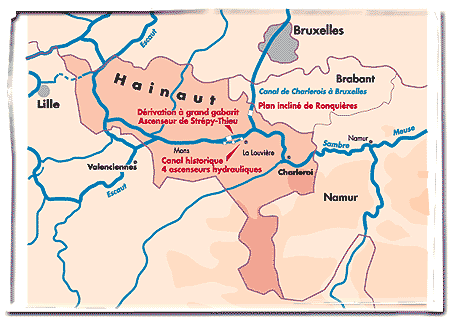| |
| |
The Canal du Centre
and its barge lifts, in Wallonia

|
|
| |
The Canal du Centre is located in the heart of Hainaut, which
stretches across the plateau between the rivers Meuse and Scheldt.
Provision of low-cost transport for this province, rich in mineral
resources but deprived of natural waterways, was a long task,
conceived under Napoleon but not completed until towards the end
of the First World War.
The Charleroi-Brussels Canal connects the Sambre (a tributary
of the Meuse) to Brussels (North-South axis), while the Canal
du Centre, extended by the Mons-Condé and Antoing-Pommeroeul canals,
connects with the Scheldt (Escaut) to the west.
A unique case in the VEV network, these canals, twice rebuilt
to larger dimensions, are "living waterways" both for inland shipping
in the 21st century and as valuable industrial heritage, recognised
as such by UNESCO in 1998. Their interest is closely bound up
in their history (see inset).
Thanks to the efforts of the Walloon partners, led by an association
chaired by Jean-Pierre Gailliez, the Canal du Centre with its
four hydraulic lifts (1888-1917) has become one of major tourist
attractions of the Walloon Region. Its interest for visitors is
reinforced by the fascinating contrast with the modern works built
for high-capacity barges, integrated in the "Regional Canals
Park " of Hainaut province: the Ronquières inclined
plane, opened in 1968, and the giant funicular barge lift of Strépy-Thieu,
which should open to traffic in 2000 or early 2001.
Without this canal system and its structures, offering a remarkable
digest of the history of hydraulic techniques, this run-down region
with its high unemployment rate could not have hoped to acquire
the status of tourist destination in its own right. This result
has been attained, and thanks to VEV the Canal du Centre is also
now becoming a permanent exhibition for all European canals. The
impact on regional identity and all sectors of the regional economy
is considerable.

|
|
| |
"History"
inset

|
|
| |
The
first link to be built was the Canal from Charleroi to Brussels,
the advantages of which were impressed upon Napoleon during
a visit to Brussels. The studies were thus initiated in 1803,
but work did not start until 1815, under the Dutch regime. Engineer
Jean-Baptiste Vifquain designed the canal for a new type of
barge, the Charleroi "baquet", with a capacity of
70 tons. The canal was opened in 1832. It soon became obvious
that this capacity was totally inadequate, and less than 10
years after inauguration, Vifquain was commissioned to study
the enlargement of the canal. The standard then being applied
for French waterways (300 ton barge, 38 m by 5 m) was adopted.
Work started in 1851, but the second tunnel on the summit level
at Godarville was not completed until 1885. In fact, through
navigation of 300-ton barges to Brussels wa snot possible until
much later, when the last of the small "baquet" locks
was removed, in 1936.
Un des quatre ascenseurs hydrauliques
du Canal du Centre
|
|
On the Scheldt side, the Mons-Condé Canal, started under
Napoleon, was completed in 1818 after some wrangling between
France and the United Provinces. To free itself from the exorbitant
tolls levied by French customs, king Willem I decided to build
the Antoing-Pommeroeul Canal, which opened in 1826. Between
Mons and the Charleroi-Brussels route, it remained to build
the missing 20 km link, but the difference in level of more
than 70 m in 7 km was considered to be unfeasible for a flight
of traditional locks, if only for water supply reasons. It is
easy to understand how the Belgian engineers were attracted
by the principle of the hydraulic lift implemented by the British
engineer Edwin Clark at Anderton in 1875. Clark was thus invited
to design a similar structure at La Louvière. The construction
contract was awarded to the private company Cockerill et Seraing,
and the first boat lift on the European continent was inaugurated
in 1888. It remained to build three more! Budget constraints
and the First World War delayed work, and it was not until 1917,
under German occupation, that the Canal du Centre was finally
opened to 300-ton barges.
|
|
|



